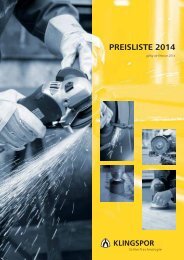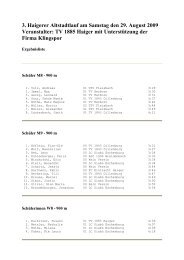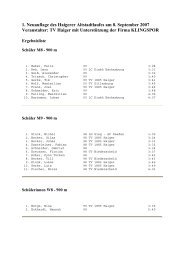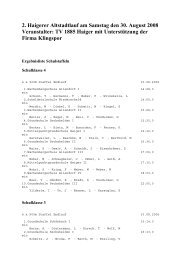CATALOGUE 2012 - Klingspor
CATALOGUE 2012 - Klingspor
CATALOGUE 2012 - Klingspor
Create successful ePaper yourself
Turn your PDF publications into a flip-book with our unique Google optimized e-Paper software.
Safety Recommendations<br />
• After mounting or re-mounting an abrasive product, conduct a trial run at<br />
operating speed with the guard in place for at least 30 seconds, standing<br />
clear of the machine before use.<br />
• Never remove guards from machines where fitted and ensure they are in<br />
good condition and properly adjusted.<br />
• Ensure that the workpiece is secure and properly supported. Ensure that<br />
work rests are properly adjusted and secure.<br />
• Never start the machine with the workpiece in contact with the abrasive<br />
product.<br />
• Never apply excessive force or shock to the abrasive product or let it<br />
overheat.<br />
• Do not grind on the part of the product that is not designed for the<br />
operation. Avoid grinding with the edge of abrasive belts, use the centre of<br />
the belt if possible.<br />
• Avoid clogging and uneven wear to ensure that the abrasive product is<br />
working efficiently. Dress frequently where appropriate.<br />
• Let the abrasive product stop naturally, not by applying pressure to its<br />
surface.<br />
• Turn off and spin out excess coolant before stopping the machine.<br />
• Do not leave abrasive belts under tension when not in use.<br />
Grinding debris - sparks, dust and fumes<br />
• Exposure to dust generated from workpiece and/or abrasive materials can<br />
result in lung damage and/or other physical injury<br />
• All dry grinding processes should be provided with adequate extraction<br />
facilities.<br />
• Do not use abrasive products near flammable materials.<br />
• The use of respirators complying with EN149 is recommended for dry<br />
grinding processes even if extraction systems are provided.<br />
• Guards where provided should be adjusted to deflect sparks and debris<br />
away from the operator.<br />
• Take additional measures to protect people working nearby.<br />
• Eye protection is recommended for all machine applications for abrasives.<br />
For hand-held machines or workpiece, goggles or full-face shields are<br />
recommended.<br />
• Eye protection with a minimum protection of EN166 Grade B is<br />
recommended.<br />
• Ensure that the correct abrasive product is selected. An unsuitable product<br />
can produce excessive debris and dust.<br />
Noise<br />
• Ear protection complying with EN352 is recommended for all appli cations<br />
where the workpiece or machine is handheld, irrespective of the noise<br />
level.<br />
• Ensure that the correct abrasive product is selected. An unsuitable product<br />
can produce excessive noise.<br />
Vibration<br />
• Processes where the workpiece or machine is hand-held can cause<br />
vibration injury.<br />
• Action needs to be taken if tingling, pins and needles or umbness is<br />
experienced after 10 minutes continuous use of the abrasive product.<br />
• The effects of vibration are more pronounced in cold conditions so keep<br />
the hands warm and exercise hands and fingers regularly. Use modern<br />
equipment with low vibration levels.<br />
• Maintain all equipment in good condition and stop the machine and have<br />
it checked if excessive vibration occurs.<br />
• Use good quality abrasive products and keep them in good condition<br />
during their life.<br />
185<br />
• Maintain mounting flanges and back-up pads in good condition and<br />
replace if worn or distorted.<br />
• Do not grip the workpiece or machine too tightly and do not exert<br />
excessive pressure on the abrasive product.<br />
• Avoid continuous use of the abrasive product.<br />
• Use the correct product. An unsuitable product can produce excessive<br />
vibration.<br />
• Don‘t ignore the physical symptoms of vibration - seek medical advice.<br />
Disposal of abrasives<br />
• Used or defective abrasives should be disposed in accordance with local or<br />
national regulations.<br />
• Further information can be obtained from material safety data sheets<br />
provided by the supplier.<br />
• Be aware that the abrasive product may be contaminated with material<br />
from the workpiece or process after use.<br />
• Disposed abrasive products should be damaged to prevent them from<br />
being taken from waste skips and re-used.<br />
SAFETY RECOMMENDATIONS<br />
FOR THE USE OF ABRASIVE BELTS<br />
1. General safety recommendations<br />
• Ensure that quality and dimensions of the belt are correct for the machine<br />
and type of application. Refer to the machine manufacturer’s instructions.<br />
• Do not use near easily flammable material.<br />
• Prevent long hair, loose clothes or jewellery from getting into contact with<br />
the machine and being pulled in. Take precautionary measures.<br />
• Ensure that people nearby are protected from chips, sparks, debris, fumes,<br />
dust or noise. Belt grinding operations may produce high concentrations of<br />
dust, gas or mist, which can represent a health hazard as well as a risk of<br />
explosion.<br />
• Do not open the guard or put down the machine until the belt has come to<br />
a complete standstill.<br />
2. Specific safety recommendations<br />
• Abrasive belts can tear. Please take precautions against risks by tearing of<br />
belt (e.g. protective clothing and devices, safety equipment of machinery).<br />
• Abrasive machines, which do not have a completely closed guard require<br />
comprehensive protective equipment of the user (e.g. protective gloves,<br />
leather aprons, face shield, dust mask).<br />
• Check the locking mechanism of the machine cover. Do not remove guards.<br />
Any contact with running belts can result in serious injuries.<br />
• When mounting, refer to direction of running advice, if necessary.<br />
• Make sure that work piece is held correctly or is mechanically secured.<br />
• Start the machine and wait until belt has reached its full operational speed<br />
before grinding.<br />
• Belts should only be used dry unless specified as suitable for wet grinding<br />
(please contact the manufac-turer if in any doubt).<br />
• Use the center of the belt, if possible, and grind as plane as possible. Avoid<br />
grinding with the edge of the belt as well as strong punctual loading e.g.<br />
through sharp or sharp-edged work pieces.<br />
• Do not exert excessive pressure and prevent the belt from overheating.<br />
• Check the belts in use periodically for wear and tear or damage (e.g. cracks<br />
at edges, fracturing or strong wear and tear in the joint) and replace the<br />
belts if necessary.<br />
Due to the extraordinary variety of applications and machine constructions,<br />
these recommendations are limited to basic aspects of safety. Further safety<br />
regulations and instructions can be taken from the respective legislation,<br />
decrees and technical standards.<br />
Service







